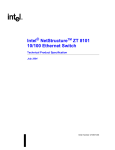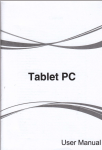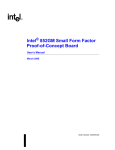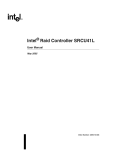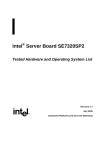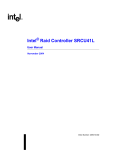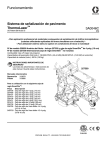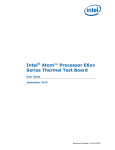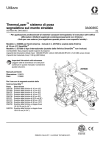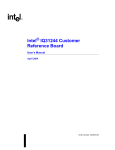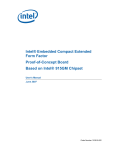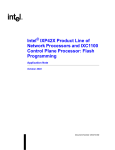Download Intel ® Raid Controller SRCS28X
Transcript
Intel® Raid Controller SRCS28X User Manual January 2005 Order Number: C89415-002 Contents INFORMATION IN THIS DOCUMENT IS PROVIDED IN CONNECTION WITH INTEL® PRODUCTS. NO LICENSE, EXPRESS OR IMPLIED, BY ESTOPPEL OR OTHERWISE, TO ANY INTELLECTUAL PROPERTY RIGHTS IS GRANTED BY THIS DOCUMENT. EXCEPT AS PROVIDED IN INTEL'S TERMS AND CONDITIONS OF SALE FOR SUCH PRODUCTS, INTEL ASSUMES NO LIABILITY WHATSOEVER, AND INTEL DISCLAIMS ANY EXPRESS OR IMPLIED WARRANTY, RELATING TO SALE AND/OR USE OF INTEL PRODUCTS INCLUDING LIABILITY OR WARRANTIES RELATING TO FITNESS FOR A PARTICULAR PURPOSE, MERCHANTABILITY, OR INFRINGEMENT OF ANY PATENT, COPYRIGHT OR OTHER INTELLECTUAL PROPERTY RIGHT. Intel products are not intended for use in medical, life saving, life sustaining applications. Intel may make changes to specifications and product descriptions at any time, without notice. Designers must not rely on the absence or characteristics of any features or instructions marked “reserved” or “undefined.” Intel reserves these for future definition and shall have no responsibility whatsoever for conflicts or incompatibilities arising from future changes to them. The Intel® Raid Controller SRCS28X may contain design defects or errors known as errata which may cause the product to deviate from published specifications. Current characterized errata are available on request. MPEG is an international standard for video compression/decompression promoted by ISO. Implementations of MPEG CODECs, or MPEG enabled platforms may require licenses from various entities, including Intel Corporation. This document and the software described in it are furnished under license and may only be used or copied in accordance with the terms of the license. The information in this document is furnished for informational use only, is subject to change without notice, and should not be construed as a commitment by Intel Corporation. Intel Corporation assumes no responsibility or liability for any errors or inaccuracies that may appear in this document or any software that may be provided in association with this document. Except as permitted by such license, no part of this document may be reproduced, stored in a retrieval system, or transmitted in any form or by any means without the express written consent of Intel Corporation. Contact your local Intel sales office or your distributor to obtain the latest specifications and before placing your product order. Copies of documents which have an ordering number and are referenced in this document, or other Intel literature may be obtained by calling 1-800-548-4725 or by visiting Intel's website at http://www.intel.com. AlertVIEW, AnyPoint, AppChoice, BoardWatch, BunnyPeople, CablePort, Celeron, Chips, CT Connect, CT Media, Dialogic, DM3, EtherExpress, ETOX, FlashFile, i386, i486, i960, iCOMP, InstantIP, Intel, Intel logo, Intel386, Intel486, Intel740, IntelDX2, IntelDX4, IntelSX2, Intel Create & Share, Intel GigaBlade, Intel InBusiness, Intel Inside, Intel Inside logo, Intel NetBurst, Intel NetMerge, Intel NetStructure, Intel Play, Intel Play logo, Intel SingleDriver, Intel SpeedStep, Intel StrataFlash, Intel TeamStation, Intel Xeon, Intel XScale, IPLink, Itanium, LANDesk, LanRover, MCS, MMX, MMX logo, Optimizer logo, OverDrive, Paragon, PC Dads, PC Parents, PDCharm, Pentium, Pentium II Xeon, Pentium III Xeon, Performance at Your Command, RemoteExpress, Shiva, SmartDie, Solutions960, Sound Mark, StorageExpress, The Computer Inside., The Journey Inside, TokenExpress, Trillium, VoiceBrick, Vtune, and Xircom are trademarks or registered trademarks of Intel Corporation or its subsidiaries in the United States and other countries. *Other names and brands may be claimed as the property of others. Copyright © Intel Corporation, 2005 2 Intel® Raid Controller SRCS28X User Manual Contents Electromagnetic Compatibility Notices This device complies with Part 15 of the FCC Rules. Operation is subject to the following two conditions: 1. This device may not cause harmful interference, and 2. This device must accept any interference received, including interference that may cause undesired operation. This equipment has been tested and found to comply with the limits for a Class B digital device, pursuant to part 15 of the FCC Rules. These limits are designed to provide reasonable protection against harmful interference in a residential installation. This equipment generates, uses, and can radiate radio frequency energy and, if not installed and used in accordance with the instructions, may cause harmful interference to radio communications. However, there is no guarantee that interference will not occur in a particular installation. If this equipment does cause harmful interference to radio or television reception, which can be determined by turning the equipment off and on, the user is encouraged to try to correct the interference by one or more of the following measures: ² ² ² ² Reorient or relocate the receiving antenna. Increase the separation between the equipment and the receiver. Connect the equipment into an outlet on a circuit different from that to which the receiver is connected. Consult the dealer or an experienced radio/TV technician for help. Intel is not responsible for any radio or television interference caused by unauthorized modification of this equipment or the substitution or attachment of connecting cables and equipment other than those specified by Intel. The correction of interferences caused by such unauthorized modification, substitution, or attachment will be the responsibility of the user. Intel RAID Controllers are tested to comply with FCC standards for home or office use. This Class B digital apparatus meets all requirements of the Canadian Interference-Causing Equipment Regulations. Cet appareil numérique de la classe B respecte toutes les exigences du Règlement sur le matériel brouilleur du Canada. This is a Class B product based on the standard of the Voluntary Control Council for Interference from Information Technology Equipment (VCCI). If this is used near a radio or television receiver in a domestic environment, it may cause radio interference. Install and use the equipment according to the instruction manual. Intel® Raid Controller SRCS28X User Manual 3 Contents Contents 1 1.1 1.2 1.3 Preface ......................................................................................................................... 7 Organization ................................................................................................................................ 7 Related Publications .................................................................................................................... 7 1.2.1 Intel RAID Software User’s Guide .................................................................................. 7 Safety Instructions ....................................................................................................................... 7 1.3.1 When Using Your Computer System.............................................................................. 8 1.3.2 When Working Inside Your Computer ............................................................................ 8 1.3.3 Protecting Against Electrostatic Discharge..................................................................... 9 2 2.1 2.2 2.3 Introduction ................................................................................................................. 11 Overview..................................................................................................................................... 11 2.1.1 Adapter Description ....................................................................................................... 12 2.1.2 Enclosure Management................................................................................................. 12 2.1.3 Operating System Support ............................................................................................ 12 2.1.4 RAID Configuration Utilities ........................................................................................... 13 Features ..................................................................................................................................... 13 Intel® Raid Controller SRCS28X Specifications ......................................................................... 14 3 3.1 3.2 3.3 3.4 3.5 Hardware Installation .................................................................................................. 15 Installation Overview .................................................................................................................. 15 Requirements ............................................................................................................................. 15 Quick Installation Instructions ..................................................................................................... 15 Detailed Installation Instructions ................................................................................................. 16 After Installing the Intel® Raid Controller SRCS28X................................................................... 19 Intel® Raid Controller SRCS28X Characteristics........................................................ 21 4 4.1 4.2 Intel® Raid Controller SRCS28X Characteristics........................................................................ 21 4.1.1 Intel® Raid Controller SRCS28X Characteristics in Detail............................................. 21 Physical and Environmental Specifications ................................................................................ 23 4.2.1 Electrical Characteristics ............................................................................................... 23 4.2.2 Thermal and Atmospheric Characteristics..................................................................... 23 4.2.3 Safety Characteristics.................................................................................................... 24 A Glossary of Terms ...................................................................................................... 25 Figures 1 2 3 4 Intel® Raid Controller SRCS28X Block Diagram ........................................................................ 11 Battery Backup Unit (BBU) Installation....................................................................................... 17 Inserting the Intel® Raid Controller SRCS28X in a PCI-X Slot ................................................... 18 Intel® Raid Controller SRCS28X Layout..................................................................................... 23 Tables 1 2 4 Intel® Raid Controller SRCS28X Characteristics........................................................................ 14 Intel® Raid Controller SRCS28X Characteristics........................................................................ 21 Intel® Raid Controller SRCS28X User Manual Contents 3 4 5 Intel® Raid Controller SRCS28X Connector Information ............................................................22 Maximum Power Requirements..................................................................................................23 Glossary of Terms ......................................................................................................................25 Revision History Date Revision October 2004 001 Intel® Raid Controller SRCS28X User Manual Description Initial release 5 Contents 6 Intel® Raid Controller SRCS28X User Manual Preface 1 This document assumes that you have some familiarity with RAID controllers and related support devices. The people who benefit from this book are: • Anyone installing an Intel® Raid Controller SRCS28X storage adapter into a system • Engineers who are designing an Intel® Raid Controller SRCS28X into a system • Engineers and managers who are evaluating the Intel® Raid Controller SRCS28X storage adapter for possible use in a system 1.1 Organization Use this manual to install and configure your Intel® Raid Controller SRCS28X in the host system. The information in this document is independent of the back-end bus that the system uses and applies to both MegaRAID SCSI storage adapters and Serial ATA storage adapters. This document has the following chapters and appendixes: • Chapter 2, “Introduction”describes the Intel® Raid Controller SRCS28X. • Chapter 3, “Hardware Installation”describes how to install an Intel® Raid Controller SRCS28X in a system. • Chapter 4, “Intel® Raid Controller SRCS28X Characteristics”provides the environmental and electrical specifications for the Intel® Raid Controller SRCS28X. This chapter also provides the mechanical drawing, jumper definitions, and connector locations for the Intel® Raid Controller SRCS28X. • Appendix A lists and explains terms and abbreviations that are used in this manual. • Appendix B provides forms to send or fax to Intel if you encounter difficulty with your Intel® Raid Controller SRCS28X. 1.2 Related Publications 1.2.1 Intel RAID Software User’s Guide This document is on the resource CD included with the RAID Controller. 1.3 Safety Instructions Use the following safety guidelines to help protect your computer system from potential damage and to ensure your own personal safety. Intel® Raid Controller SRCS28X User Manual 7 Preface 1.3.1 When Using Your Computer System As you use your computer system, observe the following safety guidelines: Caution: Do not operate your computer system with any cover(s) (such as computer covers, bezels, filler brackets, and front-panel inserts) removed: • To help avoid damaging your computer, be sure the voltage selection switch on the power supply is set to match the alternating current (AC) power available at your location: — 115 volts (V)/60 hertz (Hz) in most of North and South America and some Far Eastern countries such as Japan, South Korea, and Taiwan — 230 V/50 Hz in most of Europe, the Middle East, and the Far East. Also be sure your monitor and attached peripherals are electrically rated to operate with the AC power available in your location. • To help avoid possible damage to the system board, wait five seconds after turning off the system before removing a component from the system board or disconnecting a peripheral device from the computer. • To help prevent electric shock, plug the computer and peripheral power cables into properly grounded power sources. These cables are equipped with 3-prong plugs to ensure proper grounding. Do not use adapter plugs or remove the grounding prong from a cable. If you must use an extension cable, use a 3-wire cable with properly grounded plugs. • To help protect your computer system from sudden, transient increases and decreases in electrical power, use a surge suppressor, line conditioner, or uninterruptible power supply. • Be sure nothing rests on your computer system’s cables and that the cables are not located where they can be stepped on or tripped over. • Do not spill food or liquids on your computer. If the computer gets wet, consult the documentation that came with it. • Do not push any objects into the openings of your computer. Doing so can cause fire or electric shock by shorting out interior components. • Keep your computer away from radiators and heat sources. Also, do not block cooling vents. Avoid placing loose papers underneath your computer; do not place your computer in a closedin wall unit or on a rug. 1.3.2 When Working Inside Your Computer Note: Do not attempt to service the computer system yourself, except as explained in this guide and elsewhere in Intel documentation. Always follow installation and service instructions closely. 1. Turn off your computer and any peripherals. 2. Disconnect your computer and peripherals from their power sources. Also disconnect any telephone or telecommunications lines from the computer. 3. Doing so reduces the potential for personal injury or shock. Also note these safety guidelines: • When you disconnect a cable, pull on its connector or on its strain-relief loop, not on the cable itself. Some cables have a connector with locking tabs; if you are disconnecting this type of cable, press in on the locking tabs before disconnect the cable. As you pull connectors apart, 8 Intel® Raid Controller SRCS28X User Manual Preface keep them evenly aligned to avoid bending any connector pins. Also, before you connect a cable, make sure both connectors are correctly oriented and aligned. • Handle components and cards with care. Don’t touch the components or contacts on a card. Hold a card by its edges or by its metal mounting bracket. Hold a component such as a microprocessor chip by its edges, not by its pins. 1.3.3 Protecting Against Electrostatic Discharge Static electricity can harm delicate components inside your computer. To prevent static damage, discharge static electricity from your body before you touch any of your computer’s electronic components, such as the microprocessor. You can do so by touching an unpainted metal surface, such as the metal around the card-slot openings at the back of the computer. As you continue to work inside the computer, periodically touch an unpainted metal surface to remove any static charge your body may have accumulated. In addition to the preceding precautions, you can also take the following steps to prevent damage from electrostatic discharge (ESD): • When unpacking a static-sensitive component from its shipping carton, do not remove the component from the antistatic packing material until you are ready to install the component in your computer. Just before unwrapping the antistatic packaging, be sure to discharge static electricity from your body. • When transporting a sensitive component, first place it in an antistatic container or packaging. Handle all sensitive components in a static-safe area. If possible, use antistatic floor pads and workbench pads. Intel® Raid Controller SRCS28X User Manual 9 Preface 10 Intel® Raid Controller SRCS28X User Manual Introduction 2 This chapter describes the Intel® Raid Controller SRCS28X and consists of the following sections: • Section 2.1, “Overview” on page 11 • Section 2.2, “Features” on page 13 • Section 2.3, “Intel® Raid Controller SRCS28X Specifications” on page 14 2.1 Overview The Intel® Raid Controller SRCS28X provides a high-performance intelligent PCI-X to Serial ATA (Peripheral Component Interconnect-X to High Speed Serialized AT Attachment) interface with RAID (Redundant Array of Independent Disks) control capabilities. You can install the SATA board on a PCI-X bus and use it to connect Serial ATA drives to the host computer over a Serial ATA cable. The Intel® Raid Controller SRCS28X is an ideal RAID solution for the internal storage of workgroup, departmental, and entry-level enterprise systems. It offers a cost-effective way to implement RAID in a server. Figure 1. Intel® Raid Controller SRCS28X Block Diagram Intel® Raid Controller SRCS28X User Manual 11 Introduction 2.1.1 Adapter Description The Intel® Raid Controller SRCS28X is a half-size storage adapter (6.875” x 4.2”) that provides support for eight Serial ATA ports. You can attach a daughtercard to provide battery backup support. The Intel® Raid Controller SRCS28X uses an Intel 80331 I/O Processor to support the Serial ATA ports. The Intel 80331 I/O Processor provides the intelligent RAID management capabilities. The Intel® Raid Controller SRCS28X supports RAID 0, 1, 5, 10, and 50. 2.1.2 Enclosure Management In addition, the Intel® Raid Controller SRCS28X offers enclosure management through the same protocols used for SCSI Accessed Fault-Tolerant Enclosures (SAF-TE), using an I2C interface to communicate with the storage enclosure processor (SEP). This feature allows you to use RAID capabilities provided by the Intel® Raid Controller SRCS28X in an enclosure containing your hard drives. The Intel® Raid Controller SRCS28X uses the SAF-TE command protocol to communicate control and status with the storage enclosure processor (SEP). The SAF-TE protocol defined in the SATA II specification is used to communicate or perform SAF-TE operations such as setting the drive state and turning off/on LED with the SEP device. SEP is a micro controller resides on SATA backplane. It senses drive inserted status, drive activity and status LEDs near each hard drive slot. The drive status is reported and LED control performed according to commands through I2C bus. LEDs are located on the backplane near each hard drive slot. 2.1.3 Operating System Support The Intel® Raid Controller SRCS28X supports several major operating systems. Intel provides device drivers and RAID management tools for operating systems on the resource CD that accompanies the Intel® Raid Controller SRCS28X. In addition, you can download the latest drivers and software on the Intel support web site: http:// www.support.intel.com. Refer to the Software User’s Guide on the Resource CD for instructions for installing the device drivers. Be sure to use the latest Service Packs provided by the operating system manufacturer and review the readme file that accompanies the driver. The Intel® Raid Controller SRCS28X supports the following operating systems: • • • • • • Note: 12 Microsoft* Windows* XP Microsoft* Windows* 2000 Microsoft* Windows Server* 2003 Novell* NetWare* Red Hat* Linux*, and SuSE* Linux* The operating systems supported by this controller may not be supported by your server board. Please refer to the tested OS list for your server board at http://support.intel.com/support/ Intel® Raid Controller SRCS28X User Manual Introduction motherboards/server/. See also the tested hardware and operating system list for the Intel® Raid Controller SRCS28X to make sure the RAID controller supports your operating system. 2.1.4 RAID Configuration Utilities The Intel® Raid Controller SRCS28X provides several configuration utilities that you can use to configure arrays and logical drives. The utilities are listed in Section 2.2, “Features” on page 13 in this chapter. For information on configuring RAID arrays and using the configuration and management tools, refer to the Software User’s Guide. 2.2 Features This section highlights the features of the Intel® Raid Controller SRCS28X. The Intel® Raid Controller SRCS28X offers the following: • Provides eight internal Serial ATA ports • Support the Serial ATA, Revision 1.0, specification and Serial ATA II Extensions to Serial ATA 1.0: — Provide a 150 Mbytes/s and 300 Mbytes/s bus speed — Use a low-cost, small 7-pin connector with thin, flexible cables — Use low-voltage signalling levels to reduce current draw, EM emission, and signal switching time — Support enclosure management, using an I2C interface to communicate with a storage enclosure processor • Support the PCI-X Specification, Version 1.0a: — Provide up to 64-bit, 133 MHz data transfers from the host system to the Intel® Raid Controller SRCS28X — Are backward compatible with previous implementations of the PCI specification — Conform to the half-size PCI form factor • RAID 0, 1, 5, 10, and 50 I/O Processor: — Use an Intel 80331 to provide intelligent RAID management — Provide hardware-based exclusive-OR generation and checking • Support RAID Management tools that enable the user to: — Configure logical disks and physical arrays — Fail physical disks and logical arrays — Rebuild data from failed drives while the system is still operational — Specify the rebuild rate — Perform online RAID level migration • Provide an optional battery backup via a daughter card with battery and power circuitry Intel® Raid Controller SRCS28X User Manual 13 Introduction 2.3 Intel® Raid Controller SRCS28X Specifications Table 1 summarizes the specifications of the Intel® Raid Controller SRCS28X. Table 1. Intel® Raid Controller SRCS28X Characteristics Intel® Raid Controller SRCS28X Feature Number of Ports 8 Serial ATA Bus Speed Serial ATA Data Transfer 1.5 Gbps and 3.0 Gbps Rate1 150 MBps, 300 MBps Intelligent RAID Management Yes, using the Intel 80331 processor PCI Bus Width and Speed 64-bit, 133 MHz PCI Data Transfer Ratea RAID Levels 1064 MBps 0, 1, 5, 10, and 50 SDRAM Support 128 Mbytes ECC DDR 333 SDRAM Cache Function Write-back, Write-through, Adaptive Read Ahead, Non-Read Ahead, Read Ahead, Cache I/O, Direct I/O Online Expansion Yes Hot Spare Pool Yes Hot Swap Yes Hardware Exclusive-OR Yes Enclosure Management Support Yes Optional BBU (sold separately) Yes a. Theoretical transfer rate 14 Intel® Raid Controller SRCS28X User Manual Hardware Installation 3 This chapter describes the hardware installation of the Intel® Raid Controller SRCS28X. This chapter consists of the following sections: • • • • • 3.1 Section 3.1, “Installation Overview” on page 15 Section 3.2, “Requirements” on page 15 Section 3.3, “Quick Installation Instructions” on page 15 Section 3.4, “Detailed Installation Instructions” on page 16 Section 3.5, “After Installing the Intel® Raid Controller SRCS28X” on page 19 Installation Overview The following steps provide an overview of the operations to install and configure the Intel® Raid Controller SRCS28X for RAID operations. 1. Install the Hardware. Refer to Section 3.3, “Quick Installation Instructions” on page 15 or Section 3.4, “Detailed Installation Instructions” on page 16 for hardware installation instructions. 2. Configure the system BIOS. Refer to the system documentation for more information. 3. Run the setup utility to configure the Serial ATA drives into a RAID array. Refer to the Intel Software Guide for RAID Products for more information. 4. Install the operating system driver. Refer to the Intel Software Guide for RAID Products for more information. 5. Install and run the Intel® Raid Controller SRCS28X to manage the RAID system configuration and performance. Refer to the Software User’s Guide for more information. 3.2 Requirements You must have the following items to install and use a Intel® Raid Controller SRCS28X: • An Intel® Raid Controller SRCS28X and device driver • Host computer with an available PCI-X expansion slot • Serial ATA disk drives and cables 3.3 Quick Installation Instructions Follow these instructions to install your Intel® Raid Controller SRCS28X if you are comfortable with the installation procedure. 1. Unpack the Intel® Raid Controller SRCS28X and inspect it for damage. Intel® Raid Controller SRCS28X User Manual 15 Hardware Installation 2. Power down the system and unplug the power cord. 3. Remove the cover from the computer. 4. Configure the jumpers on the Intel® Raid Controller SRCS28X. 5. Insert the Intel® Raid Controller SRCS28X in an available PCI-X slot. 6. Configure the Serial ATA devices according to the instructions for each device. 7. Connect the Serial ATA cables between the Intel® Raid Controller SRCS28X and the Serial ATA devices. 8. Replace the computer cover, plug the power cord in, and power up the system. 3.4 Detailed Installation Instructions The following steps provide detailed installation instructions. 1. Unpack the Intel® Raid Controller SRCS28X and inspect it for damage. Unpack and install the Intel® Raid Controller SRCS28X in a static-free environment. Remove the Intel® Raid Controller SRCS28X from the anti-static bag and inspect it for damage. Contact Intel or your Intel support representative if the storage adapter appears damaged. 2. (Optional, required to enable Write Back Cache) Attach the Battery Backup Unit (BBU) to the adapter. a. Remove the Battery Backup Unit from its packaging. b. Connect the wire from the battery to the Circuit Board. c. Position the BBU over the RAID adapter so the connectors line up. Press the BBU on the adapter. d. Turn the Adapter over. e. Using the three screws, secure the BBU to the RAID Adapter. 16 Intel® Raid Controller SRCS28X User Manual Hardware Installation Figure 2. Battery Backup Unit (BBU) Installation A B C 3. Power down the system. Turn off the computer and physically remove the power cord from the back of the power supply. Remove the cover from the computer chassis. Disconnect the system from any networks. 4. Configure the jumpers on the Intel® Raid Controller SRCS28X. Configure the jumper settings on the Intel® Raid Controller SRCS28X using the jumper definitions and locations provided in Chapter 4, “Intel® Raid Controller SRCS28X Characteristics.” 5. Carefully insert the Intel® Raid Controller SRCS28X. Align the Intel® Raid Controller SRCS28X to a PCI-X slot. Press down gently but firmly to properly seat the Intel® Raid Controller SRCS28X in the slot. Figure 3 shows how to insert the Intel® Raid Controller SRCS28X in a slot. Caution: Do not apply pressure to the battery backup unit when installing the board. Intel® Raid Controller SRCS28X User Manual 17 Hardware Installation Figure 3. Inserting the Intel® Raid Controller SRCS28X in a PCI-X Slot Bracket Screw Press Here Press Here Edge of Mother Board 64-bit Slots (3.3 V) 6. Screw the bracket to the computer frame. 7. Configure the Serial ATA devices and install them in the host system computer case. See the documentation for the Serial ATA device for any pre-installation configuration requirements. 8. Connect the Serial ATA cables between the Intel® Raid Controller SRCS28X and the Serial ATA devices. Chapter 4, “Intel® Raid Controller SRCS28X Characteristics,” shows the connector locations on the Intel® Raid Controller SRCS28X. 9. Replace the computer cover and power up the system. Replace the computer cover and reconnect the power cords. Turn power on to the computer. The BIOS configuration utility prompt times out after several seconds. The second portion of the BIOS message displays the number, firmware version and cache SDRAM size. The numbering of the controller follows the PCI slot scanning order used by the motherboard. 18 Intel® Raid Controller SRCS28X User Manual Hardware Installation 3.5 After Installing the Intel® Raid Controller SRCS28X After you install the Intel® Raid Controller SRCS28X, you must install the device driver and define the logical drives and physical disk arrays. Refer to the Software User’s Guide for detailed device driver installation steps. Refer to it for detailed steps for configuring physical arrays and logical drives. Intel® Raid Controller SRCS28X User Manual 19 Hardware Installation 20 Intel® Raid Controller SRCS28X User Manual Intel® Raid Controller SRCS28X Characteristics 4 This chapter describes the characteristics of the Intel® Raid Controller SRCS28X. This chapter includes these topics: • Section 4.1, “Intel® Raid Controller SRCS28X Characteristics” on page 21 • Section 4.2, “Physical and Environmental Specifications” on page 23 4.1 Intel® Raid Controller SRCS28X Characteristics The Intel® Raid Controller SRCS28X conforms to the PCI-X Local Bus Specification, Revision 1.0a and is backward compatible with previous revisions of the PCI specification. The Intel® Raid Controller SRCS28X supports the Serial ATA Specification, version 1.0, and Serial ATA II Extensions to Serial ATA 1.0, Revision 1.0. Table 2 summarizes the characteristics of the Intel® Raid Controller SRCS28X. Table 2. Intel® Raid Controller SRCS28X Characteristics Adapter Intel® Raid Controller SRCS28X Ports 8 RAID Levels 0, 1, 5, 10, and 50 PCI Bus Mode 64 bits, 133 MHz PCI-X Board Dimensions 6.6 x 4.2 inches (168 × 107 mm) The following subsections provide detailed descriptions of the Intel® Raid Controller SRCS28X. 4.1.1 Intel® Raid Controller SRCS28X Characteristics in Detail The Intel® Raid Controller SRCS28X is an intelligent RAID controller that provides eight Serial ATA ports and support RAID 0, RAID 1, RAID 5, RAID 10, and RAID 50. The Intel® Raid Controller SRCS28X does the following: • Supports eight Serial ATA ports: — Uses differential signalling — Transfers data in frames — Supports Serial ATA power management • Are compliant with the PCI-X and PCI 2.3 Specifications • Support up to a 64-bit/133 MHz PCI-X interface: — Function in a 64-bit PCI slot — Function at 133 MHz, 100 MHz, or 66 MHz — Support 3.3 V Intel® Raid Controller SRCS28X User Manual 21 Intel® Raid Controller SRCS28X Characteristics — Are backward compatible with previous versions of the PCI specification Table 3 defines the connectors on the Intel® Raid Controller SRCS28X. Table 3. Intel® Raid Controller SRCS28X Connector Information Jumper Type Description J1 LED SATA Activity Connector 2-pin connector. When lit, it indicates SATA activity on one or more SATA drives. J3 Battery Backup Connector (optional) Connects Battery Backup Unit SATA Ports Ports 0 – 7. Used to attach the cables from the adapter to the SATA hard drives. J6 Serial Port RS232 Interface 3-pin connector. Used for diagnostic purposes. J7 I2C Interface 4-pin connector (Engineering use only) Write Pending Activity (dirty cache) LED 2-pin connector. When lit, it indicates that the onboard cache memory contains data and that a write from cache to the hard drives is pending. Serial EEPROM Interface 2-pin connector. When equipped with a connector from a serial programming device, J9 provides the interface for programming the onboard manufacturing-tracking serial EEPROM. J2, J4, J5, J12 J8 J9 2-pin connector. J10 Jumpered: BIOS disabled BIOS Disable Unjumpered: BIOS enabled This is the default. 2-pin connector. J11 Jumpered: Causes CPU core to be held in reset (mode 0) Mode Select Unjumpered: Normal board operation is open (mode 3). This is the default. 3-pin connector. J13 SAF-TE Hardware Connector The I2C Interface is for communication with storage enclosure processor (SED) devices Figure 1 provides the layout of the Intel® Raid Controller SRCS28X. 22 Intel® Raid Controller SRCS28X User Manual Intel® Raid Controller SRCS28X Characteristics Figure 2 provides the layout of the Intel® Raid Controller SRCS28X. Figure 4. Intel® Raid Controller SRCS28X Layout J1 J3 J2 J8 J4 Port 5 Port 4 J5 Port 3 Port 2 J12 Port 1 Port 0 U15 J13 J6 J9 J7 J10 J11 Port 7 Port 6 P1 4.2 Physical and Environmental Specifications The design and implementation of the Intel® Raid Controller SRCS28X minimizes electromagnetic emissions, susceptibility to radio frequency energy, and the effects of electrostatic discharge. The board carries the CE mark, C-Tick mark, FCC Self-Certification logo, Canadian Compliance Statement, Korean MIC, Taiwan BSMI, Japan VCCI, and meets the requirements of CISPR Class B. 4.2.1 Electrical Characteristics Table 4 lists the maximum power requirements for the Intel® Raid Controller SRCS28X under normal operation. Table 4. 4.2.2 Maximum Power Requirements Host Adapter 5.0 V Current 3.3 V Current Power from +5V Power from +3.3V Total Power Intel® Raid Controller SRCS28X 2.2 A .6 A 11W 2W 16w Over the Operating Range 0 °C to 40 °C with BBU 0 °C to 45 °C without BBU Thermal and Atmospheric Characteristics The atmospheric characteristics for the Intel® Raid Controller SRCS28X are: • Temperature range: 0 °C to 40 °C with BBU; 0 °C to 45 °C without BBU (dry bulb) • Relative humidity range: 20% to 80% noncondensing • Maximum dew point temperature: 32 °C Intel® Raid Controller SRCS28X User Manual 23 Intel® Raid Controller SRCS28X Characteristics • Airflow must be at least 300 linear feet per minute (LFPM) to keep the heatsink temperature below 80 °C The following parameters define the storage and transit environment for the Intel® Raid Controller SRCS28X: • Temperature range: 40 °C to 105 °C (dry bulb) • Relative humidity range: 20% to 80% noncondensing 4.2.3 Safety Characteristics All Intel® Raid Controller SRCS28Xs meet or exceed the requirements of UL flammability rating 94 V0. Each bare board is also marked with the supplier’s name or trademark, type, and UL flammability rating. Because these boards are installed in a PCI-X bus slot, all voltages are below the SELV 42.4 V limit. 24 Intel® Raid Controller SRCS28X User Manual Glossary of Terms Table 5. A Glossary of Terms Term Definition BIOS Basic Input/Output System. Software that provides basic read/write capability. Usually kept as firmware (ROM based). The system BIOS on the mainboard of a computer is used to boot and control the system. The SCSI BIOS on your host adapter acts as an extension of the system BIOS. Configuration Refers to the way a computer is setup; the combined hardware components (computer, monitor, keyboard, and peripheral devices) that make up a computer system; or the software settings that allow the hardware components to communicate with each other. Device Driver A program that allows a microprocessor (through the operating system) to direct the operation of a peripheral device. Domain Validation EEPROM Domain Validation is a software procedure in which a host queries a device to determine its ability to communicate at the negotiated Ultra320 data rate. Electronically Erasable Programmable Read Only Memory. A memory chip typically used to store configuration information. See NVRAM. Fusion-MPT Architecture Fusion-MPT (Message Passing Technology) architecture consists of several main elements: Fusion-MPT firmware, the Fibre Channel and SCSI hardware, and the operating system level drivers that support these architectures. FusionMPT architecture offers a single binary, operating system driver that supports both Fibre Channel and SCSI devices now. Host The computer system in which a RAID controller is installed. It uses the RAID controller to transfer information to and from devices attached to the SCSI bus. Host Adapter Board (HAB) A circuit board or integrated circuit that provides a device connection to the computer system. Main Memory The part of a computer’s memory which is directly accessible by the CPU (usually synonymous with RAM). NVRAM NonVolatile Random Access Memory. Actually an EEPROM (Electronically Erasable Read Only Memory chip) used to store configuration information. See EEPROM. PCI and PCI-X Peripheral Component Interconnect. A high performance local bus specification that allows connection of devices directly to computer memory. The PCI Local Bus allows transparent upgrades from 32-bit data path at 33 MHz to 64-bit data path at 33 MHz, and from 32-bit data path at 66 MHz to 64-bit data path at 66 MHz. Peripheral Devices A piece of hardware (such as a video monitor, disk drive, printer, orCD-ROM) used with a computer and under the computer’s control. SCSI peripherals are controlled through a SCSI SRCU42X controller (host adapter). Intel® Raid Controller SRCS28X User Manual 25 Glossary of Terms 26 Intel® Raid Controller SRCS28X User Manual



























